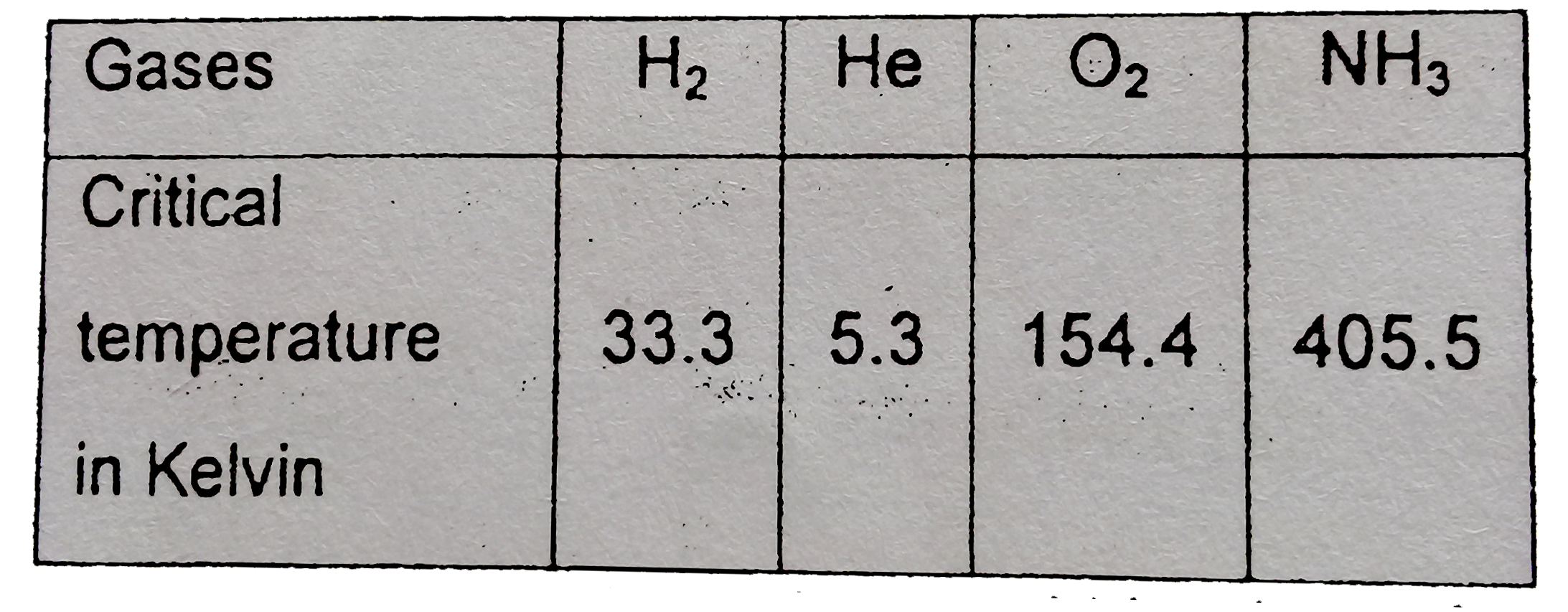Gases posses characteristic critical temperature which depends upon the magnitude of intermolecular forces between the particles. Following are the critical temperatures of some gases.
GasesH2HeO2N2Critical temperature in kelvin33.25.3154.3126
From the above data what would be the order of liquefaction of these gases ? Start writing the order from the gas liquefying first
H2,He,O2,N2
He,O2,H2,N2
N2,O2,He,H2
O2,N2,H2,He
The correct Answer is:D
Higher the critical temperature, more easily is the gas liquefied. Hence, order of liquefaction starting with the gas liquefying first will be O2,N2,H2,He
Topper's Solved these Questions
- STATES OF MATTER BOOK - ERRORLESSCHAPTER - STATES OF MATTER EXERCISE - NCERT BASED QUESTIONS (VISCOSITY & SURFACE TENSION)
11 Videos
- STATES OF MATTER BOOK - ERRORLESSCHAPTER - STATES OF MATTER EXERCISE - PAST YEAR QUESTIONS
34 Videos
- STATES OF MATTER BOOK - ERRORLESSCHAPTER - STATES OF MATTER EXERCISE - NCERT BASED QUESTIONS (REAL GASES AND VAN DER WAALS EQUATION)
21 Videos
- SOME BASIC CONCEPTS OF CHEMISTRYBOOK - ERRORLESSCHAPTER - SOME BASIC CONCEPTS OF CHEMISTRYEXERCISE - ASSERTION & REASON
10 Videos
- STRUCTURE OF ATOMBOOK - ERRORLESSCHAPTER - STRUCTURE OF ATOMEXERCISE - Assertion & Reason
16 Videos
Similar Questions
Gases possess characteristic critical temperature which depends upon the magnitude of intermolecular forces between the gas particles. Critical temperatures of ammonia and carbon dioxide are 405.5 K and 304.10 K respectively. Which of these gases will liquify first when you start cooling from 500 K to their critical temperature ?
View SolutionGases possess characteristic critical temperature which depends upon the magnitude of intermolecualr forces between the gas particles, critical temperatures of ammonia and carbon dioxide are 405.5 K and 304.10 K respectively. Which of these gases will liquefy first when you start cooling from 500 K to their critical temperature ?
View Solution
Knowledge Check
GasH2HeO2N2Critical temp. ink33.25.3154.3126
From the above data, what would be the order of liquefication of these gases? Start writing the order for the gas which liquefies first:AH2,H,O2,N2BH2,O2,H2,N2CN2,O2,He,H2DO2,N2,H2,HeGases posses characteristic critical temperature which depends upon the magnitude of intermolecular forces between the particles. Following are the critical temperatures of some gases.
GasesH2HeO2N2Critical temperature in kelvin33.25.3154.3126
From the above data what would be the order of liquefaction of these gases ? Start writing the order from the gas liquefying firstAH2.He,O2,N2BHe,O2,H2,N2CN2,O2,He,H2DO2,N2,H2,He
Gases possess characteristic critical temperature which depends upon the magnitude of intermolecular forces between the particles. Following are the critical tempeatures of some gases. From the above data what would be the order of liquefaction of these gases? Start writing the order from the gas liquefying first.AHe,H2,O2,NH3BNH3,O2,H2,HeCNH3,He,O2,H2Dnone of these
Gases possess characteristic critical temperature which depends upon the magnitude of intermolecular forces between the gas particles. Critical temperatures of ammonia and carbon dioxide are 405.5 K and 304.10 K respectively. Which of these gases will liquify first when you start cooling from 500 K to their critical temperature ?
View SolutionGivenGasH2CH4CO2SO2critical 33190304630
temperature /K
ON the basic of data given above , predict which of the following gases shows least a dsorption on a definite amount of charcoal ?
View SolutionOn the basis fo data given below predict which of the following gases shows least adsorption on a definite amount of charcoal?
GasCO2SO2CH4H2Critical temp./K30463019033
View SolutionGivenGasH2CH4CO2SO2critical 33190304630
temperature /K
ON the basic of data given above , predict which of the following gases shows least a dsorption on a definite amount of charcoal ?
View SolutionOn the basis of data given below predict which of the following gases shows least adsorption on a definite amount of charcoal?
GasCO2SO2CH4H2Critical temp./K30463019033
View Solution
